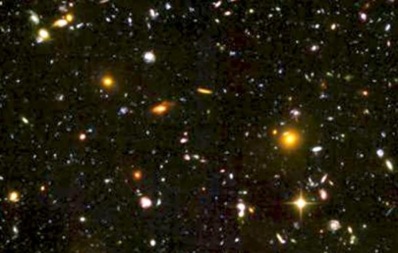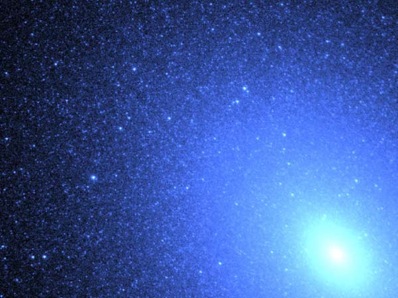



|

|

Some galaxies hit
the snooze button
GEMMA LAVENDER
ASTRONOMY NOW
Posted: 05 July 2011


Astronomers probing into the distant Universe have revealed that galaxies are either wide awake, actively forming new stars, or are in a deep slumber where they are not creating new stars at all.
Although scientists have known for several years that galaxies in our nearby Universe seem to fall into one of these two states, a new survey of the distant Universe shows that even very young galaxies as far as 12 billion light years are also either awake or asleep, telling scientists that galaxies have behaved this way for more than 85 percent of the history of the Universe.

Bluer galaxies are actively ‘awake’ and forming stars, while redder galaxies have fallen ‘asleep’. Image Credit: NASA, ESA, S.Beckwith (STScI) and the HUDF team.
In order to determine if these giant structures were asleep or awake, a new set of filters were fabricated, with each being sensitive to differing wavelengths of light and which were used on the four-metre telescope at Kitt Peak in Arizona. A total of 75 nights were spent by Yale University graduate Kate Whitaker and her colleagues collecting light from around 40,000 galaxies ranging in distance from the nearby Universe into the depths of 12 billion light years.
The survey, which is the deepest and most complete ever made at these distances and wavelengths, was deciphered based on the colour of the light emitted by a galaxy in either of the dual states. “Blue, massive stars live very short lives relative to red, lower mass stars and are much more luminous; they dominate the light of a galaxy but also consequently burn their ‘fuel’ much quicker,” says Kate Whitaker, who is lead author of the research paper, which is published in the 20 June online edition of The Astrophysical Journal. “Active, ongoing star formation means that these young, blue stars are continuously being born and so a galaxy will have a blue colour.”
The team found that galaxies which emitted a blueish light belonged to a wakeful galaxy, whereas light emitted by passive, sleepy galaxies tend towards the redder end of the spectrum. They also found that most galaxies prefer to be wide awake than have a ‘lie-in’, telling the scientists that there are, in fact, more active galaxies throughout the Universe and that current theories suggesting that these structures start out actively forming stars, before eventually shutting down, are correct. “There are likely very few galaxies that exist in an ‘in-between’ state because of the lifetimes of blue stars relative to red stars,” says Whitaker. “After the most luminous blue stars have died, the remaining slightly smaller stars are less blue [and therefore green], so a galaxy in the in-between state would have a green-white colour.” She adds: “Because massive, blue stars have short lifetimes, a galaxy that switches off will very quickly transition from a blue to red colour.”

M32, an an example of a galaxy emitting blue light which originates from bright, blue stars. Image Credit: Thomas M. Brown (GSFC) et al., NASA.
The remarkable discovery, where such young galaxies in the distant Universe have switched themselves off, has lead to many other questions waiting to be answered. One of these questions is open, says Whitaker, and surrounds whether the sleeping galaxies have completely shut down. The study, however, suggests that active galaxies are forming stars at rates of around 50 times greater than their tired cousins.
“We call these galaxies ‘young’ because we are seeing light that they emitted about ten billion years ago, which is a much earlier period in the Universe, but they have stars that are old, relative to the age of the Universe, when their light was emitted.” says Whitaker. “It is not yet clear what causes star formation to switch off in these galaxies so early in the Universe - some thoughts are that there may be active supermassive black holes in the centre that heat up the gas in the galaxy, thereby stopping star formation. Another possible mechanism that could stop star formation would be if two galaxies merged together.”
|

|

|

|
|



